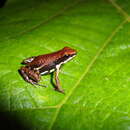pms
nòm ant ël fil


The marbled poison frog or marbled poison-arrow frog (Epipedobates boulengeri) is a species of frog in the family Dendrobatidae found in western Colombia (Cauca, Nariño, Valle del Cauca Departments, including Gorgona Island) and northwestern Ecuador, at elevations of 10–1,500 m (33–4,921 ft) asl. It likely represents a species complex of at least two species.[2][3][4]
Males measure 15–20 mm (0.59–0.79 in) and females 17–21 mm (0.67–0.83 in) in snout–vent length. Colouration is variable; dorsum is dark reddish to uniform dark brown, sides are black. There is a pale yellowish or creamy white lateral line and cream-coloured dorsolateral line. Iris is dark coppery black.[4]
Diet is varied and includes mites, ants, coleopterans, dipterans, homopterans, and colembolas.[4]
Its natural habitats are dense moist tropical rainforests as well as altered habitats like gardens and railway tunnels. It is a common species. It is threatened by habitat loss; while a somewhat adaptable species, it disappears if the habitat becomes too open and dry.[1]
{{cite journal}}: CS1 maint: multiple names: authors list (link) The marbled poison frog or marbled poison-arrow frog (Epipedobates boulengeri) is a species of frog in the family Dendrobatidae found in western Colombia (Cauca, Nariño, Valle del Cauca Departments, including Gorgona Island) and northwestern Ecuador, at elevations of 10–1,500 m (33–4,921 ft) asl. It likely represents a species complex of at least two species.